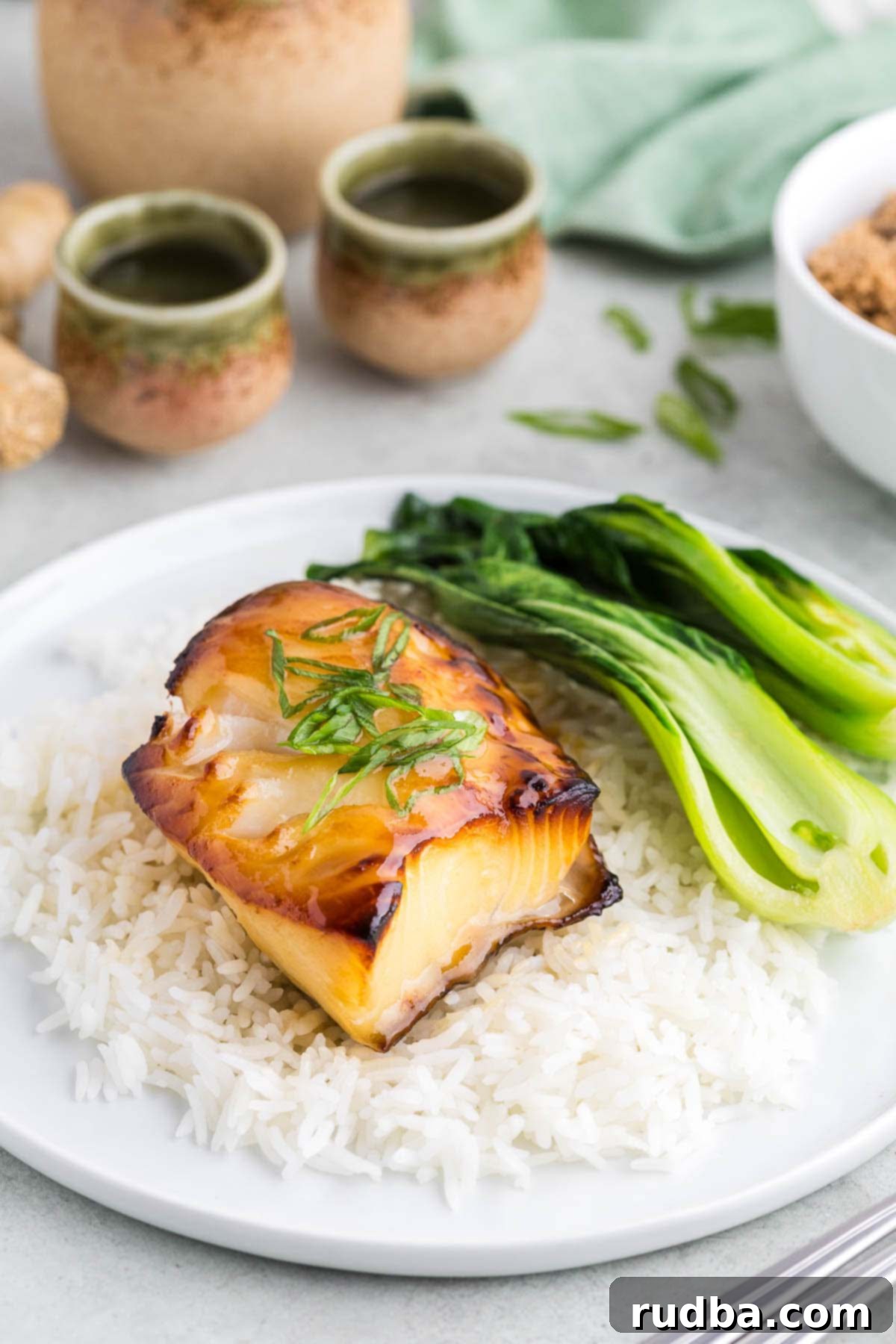Easy Miso Glazed Chilean Sea Bass: Restaurant-Quality Flavor at Home
Prepare to tantalize your taste buds with this exquisite **Miso Glazed Chilean Sea Bass** recipe! This dish, a harmonious blend of sweet and savory notes, boasts a melt-in-your-mouth texture that is simply irresistible. Achieving perfection is surprisingly simple: just a quick marination, a gentle bake, and your gourmet meal is ready. It pairs beautifully with fragrant garlic buttery rice and a medley of fresh, vibrant vegetables, making for a truly unforgettable dining experience.
For those who adore Chilean sea bass, this recipe offers a fresh take on a beloved fish. If you’re looking for more ways to enjoy this delectable seafood, don’t forget to explore my other popular recipes, including a classic baked Chilean sea bass and the incredibly convenient air fryer honey Chilean sea bass. Each recipe highlights the versatility and deliciousness of this premium fish.
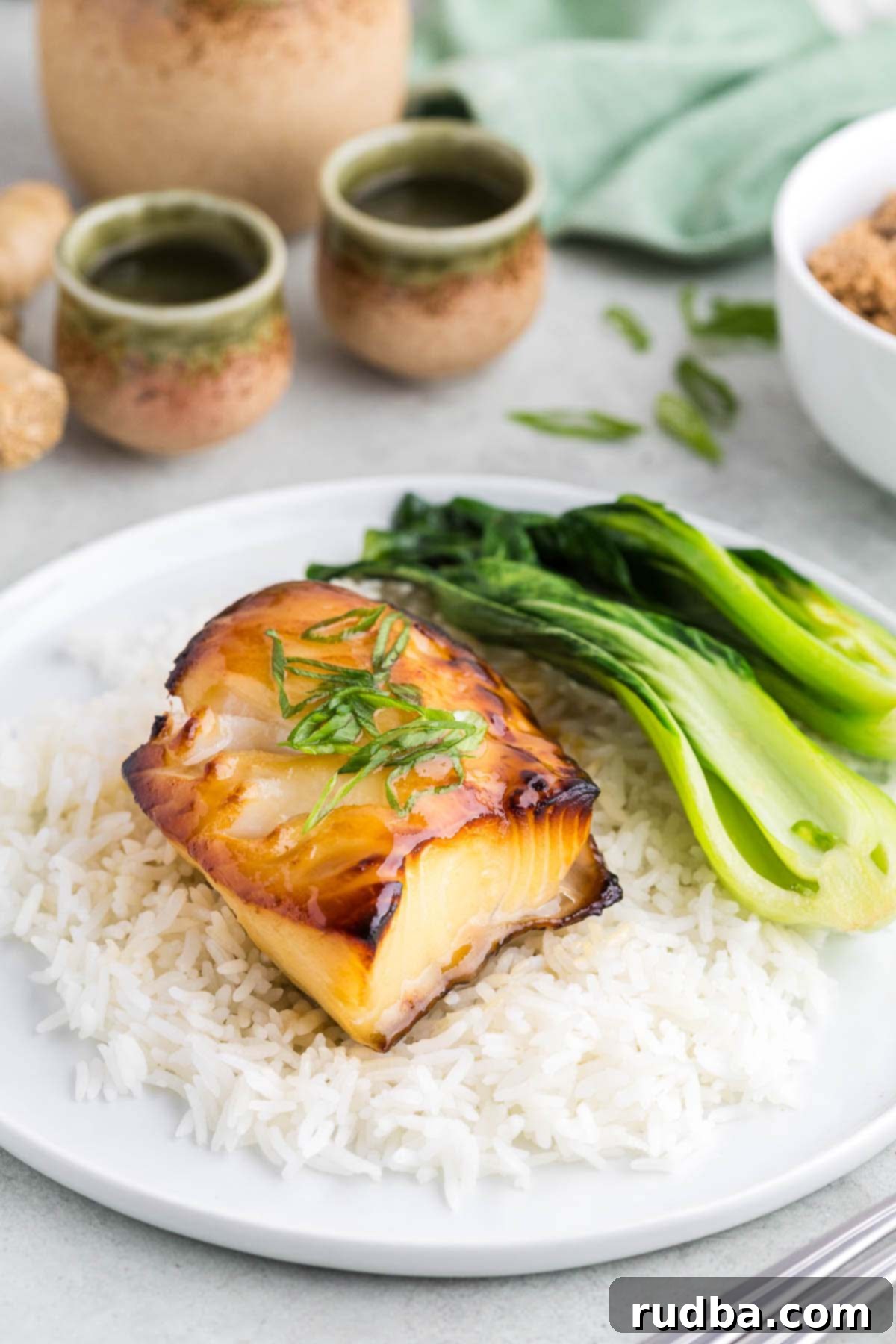
This particular **miso glazed Chilean sea bass** recipe draws its inspiration from the world-renowned Nobu restaurant, known for its iconic Black Cod with Miso. Now, you can recreate that same restaurant-quality magic right in your own kitchen, all without the hefty price tag. We firmly believe this recipe will become a cherished favorite, allowing you to enjoy luxurious flavors and a sophisticated meal whenever the craving strikes.
Table of Contents
- WHAT IS MISO GLAZED CHILEAN SEA BASS?
- WHY YOU’LL LOVE THIS RECIPE
- INGREDIENT NOTES
- TOP TIPS FOR PERFECTION
- CAN I USE THIS RECIPE WITH OTHER TYPES OF FISH?
- SERVING SUGGESTIONS
- STORAGE & REHEATING
- Miso Glazed Chilean Sea Bass Recipe
WHAT IS MISO GLAZED CHILEAN SEA BASS?
Miso Glazed Chilean Sea Bass is a beloved dish celebrated for its exquisite balance of flavors and textures. The “miso glaze” refers to a rich, umami-packed marinade made primarily from miso paste, sake, mirin, and sugar. This mixture is meticulously crafted to impart a deep, complex sweetness and savoriness to the fish. When baked, this glaze caramelizes beautifully, forming a glossy, slightly crisp exterior while keeping the inside incredibly moist and flaky.
Chilean Sea Bass, also known as Patagonian Toothfish, is highly prized for its thick, white, and buttery flesh. Its high oil content allows it to remain succulent even when cooked at higher temperatures, making it an ideal candidate for this type of intense flavoring. The richness of the fish perfectly complements the bold, fermented flavors of the miso, creating a truly unforgettable culinary experience that transports your palate to the refined world of Japanese-inspired cuisine.
WHY YOU’LL LOVE THIS RECIPE
There are numerous reasons why this **Miso Glazed Chilean Sea Bass** recipe will quickly become a go-to in your cooking repertoire:
- Restaurant Quality at Home: Inspired by the famous Nobu Black Cod with Miso, this recipe brings sophisticated, gourmet flavors to your dinner table without the exorbitant restaurant price tag. Impress your family and friends with a dish that tastes like it came from a five-star kitchen.
- Simple & Straightforward: Despite its elegant presentation and complex flavor, the actual cooking process is incredibly easy. The main steps involve preparing a quick marinade, allowing the fish to soak up the flavors, and then baking it to perfection. Minimal fuss, maximum reward!
- Healthy & Delicious: Chilean sea bass is not only incredibly tasty but also a good source of lean protein and healthy omega-3 fatty acids. Paired with the beneficial properties of miso, this dish offers a nutritious option that doesn’t compromise on flavor.
- Versatile Pairing: The sweet and savory profile of the miso glaze makes this fish incredibly versatile. It pairs wonderfully with a variety of side dishes, from simple steamed rice and vegetables to more elaborate Asian-inspired salads or noodles, allowing you to customize your meal.
- Make Ahead Friendly: The marination process is key to flavor development. You can marinate the fish overnight, making it an excellent option for meal prep or busy weeknights when you want a quick but impressive dinner.
INGREDIENT NOTES
Before you begin, ensure you have all your ingredients ready. Refer to the recipe card below for exact quantities and detailed instructions.
- Chilean Sea Bass: The star of our dish! Aim for fresh, high-quality fillets. If using frozen, make sure they are completely thawed before marinating. Thawing slowly in the refrigerator overnight is ideal to maintain texture. Chilean sea bass is known for its firm, flaky, and buttery texture, which holds up beautifully to the rich miso glaze. Look for pieces that are thick and even for consistent cooking.
- Miso Paste: This fermented soybean paste is the heart of the glaze. For this recipe, we recommend using **white miso (Shiro Miso)**, which is milder and sweeter than red or yellow miso. It offers a delicate balance that allows the other flavors to shine without being overpowering. You can find miso paste at most Asian supermarkets, specialty grocery stores, or even in the Asian aisle of larger supermarkets. It’s often found in the refrigerated section.
- Sake: A Japanese rice wine that plays a crucial role in tenderizing the fish and infusing it with authentic Japanese flavor. It also helps dissolve the miso paste and other ingredients in the marinade. Ensure you use a plain, unflavored cooking sake, not a drinking sake that might have added sugars or other ingredients that could alter the flavor profile.
- Mirin: This sweet Japanese rice wine is essential for the glaze’s characteristic shine and sweetness. Mirin has a lower alcohol content and higher sugar content than sake, contributing to the beautiful caramelization and depth of flavor. Like sake, it’s widely available in Asian markets and the international section of many grocery stores.
- Brown Sugar: We opt for brown sugar over white granulated sugar because its molasses content adds a deeper, more nuanced sweetness and helps with the rich caramelization of the glaze during cooking.
- Fresh Ginger: (Optional but highly recommended) Adding a few thin rounds of fresh ginger to the marinade imparts a subtle warmth and aromatic complexity that elevates the dish. It’s a wonderful complement to the other Japanese flavors.
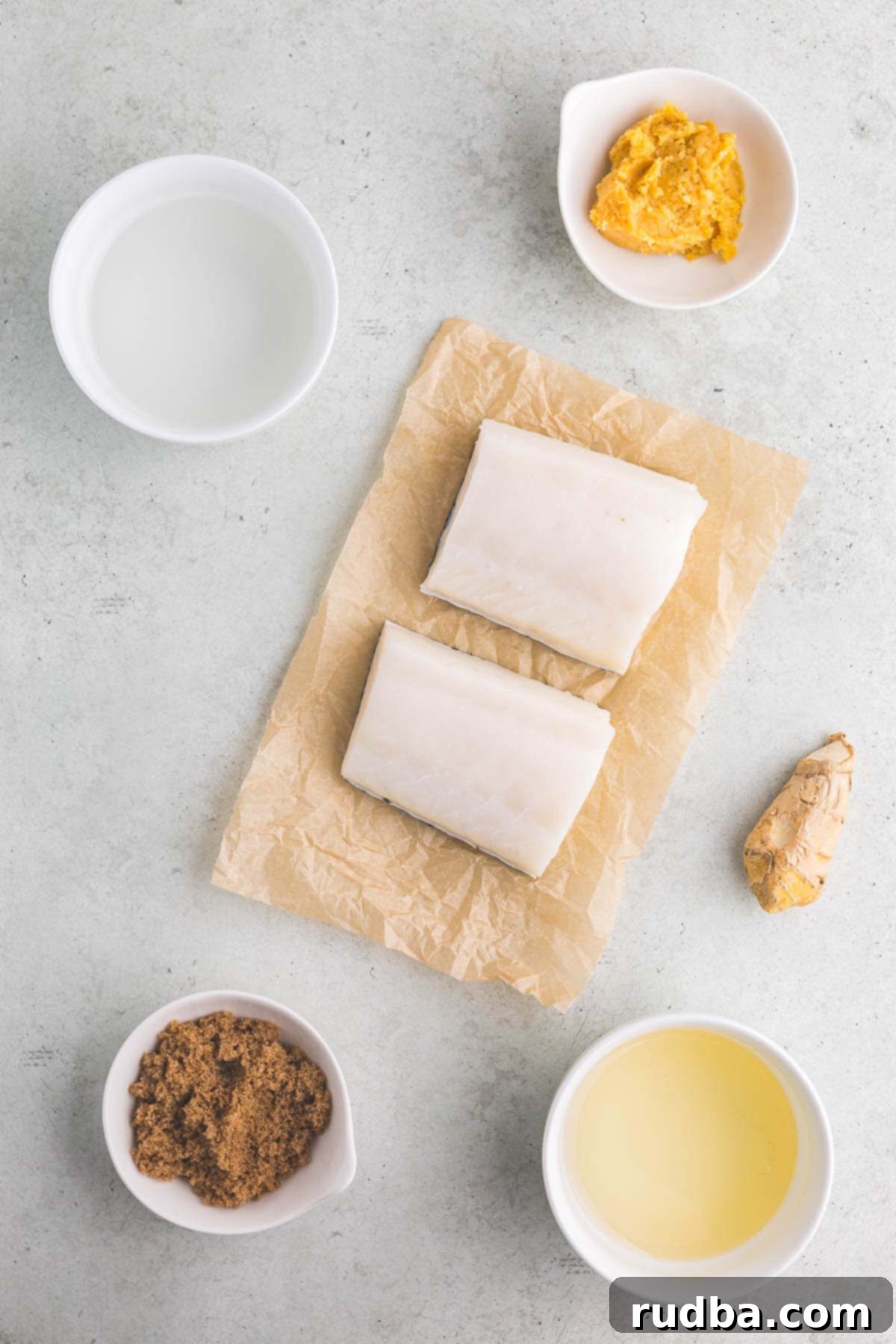
TOP TIPS FOR PERFECTION
Achieving a perfectly cooked, flavorful **Miso Glazed Chilean Sea Bass** is easy with these expert tips:
- Cool the Marinade Completely: This is a crucial step! Heating the marinade helps the miso paste dissolve and allows all the flavors to meld together beautifully. However, it is absolutely essential to cool the marinade down to at least room temperature, or even colder, before adding the fish. If you marinate the fish in a warm sauce, the heat will begin to cook the delicate fish, resulting in an unevenly cooked or overcooked product. A quick chill in the fridge can speed up this process.
- Proper Marination Time is Key: For the best flavor penetration, allow the fish to marinate in the fridge for at least one hour. For a truly deep and impactful flavor, particularly if your fish pieces are thick, marinating overnight (8-12 hours) is highly recommended. This allows the miso and other ingredients to tenderize the fish and infuse every bite.
- Bring Fish to Room Temperature Before Cooking: Take the marinated fish out of the refrigerator at least 20 minutes before you plan to cook it. Cooking cold fish straight from the fridge can lead to uneven cooking, where the outside cooks too quickly while the inside remains undercooked. Allowing it to warm slightly ensures a more even and consistent result.
- Monitor Internal Temperature for Doneness: The thicker the fish, the longer it will take to cook through. The most accurate way to determine if your Chilean sea bass is done is by using an instant-read thermometer. The fish is perfectly cooked when its internal temperature reaches 145°F (63°C). Alternatively, you can check for flakiness with a fork – it should flake easily.
- Prevent Over-Browning During Broiling: Broiling at the end helps create that beautiful caramelized glaze. Keep a close eye on the fish during this stage, as broilers can vary in intensity. If you notice the top browning too quickly, simply lower your oven rack a bit to prevent burning while still achieving that perfect golden finish.
- Do Not Overcook the Fish!: Overcooked fish becomes dry and tough, losing its signature buttery texture. Aim for just-cooked perfection – moist, tender, and flaky. The 145°F internal temperature is your best guide.
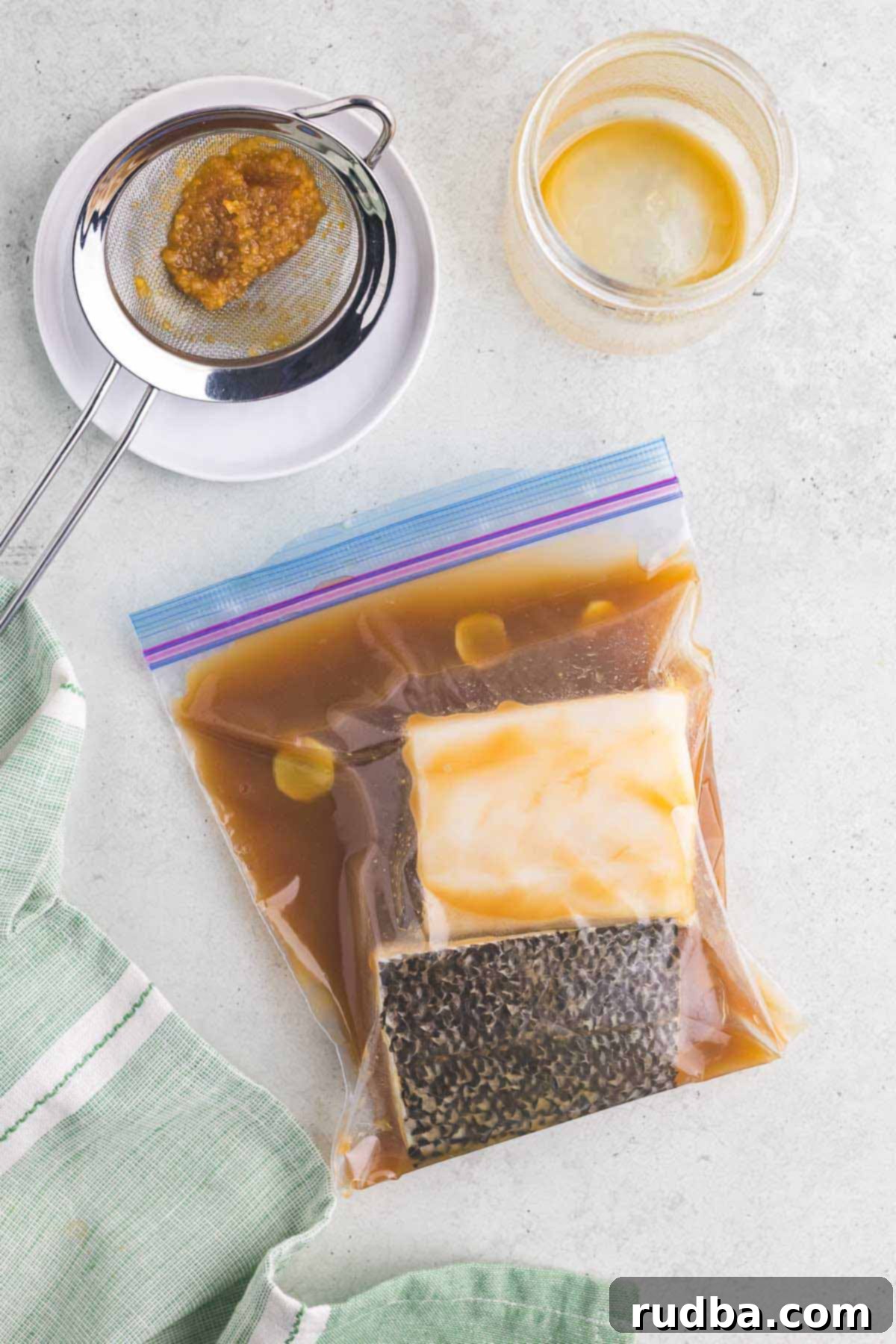
CAN I USE THIS RECIPE WITH OTHER TYPES OF FISH?
Absolutely! While Chilean sea bass is a fantastic choice for its rich, buttery texture, this versatile miso glaze recipe works wonderfully with a variety of other fish as well. If you can’t find Chilean sea bass or simply want to try something different, consider these excellent alternatives:
- Halibut: A firm, white fish with a delicate flavor that stands up well to the robust miso glaze.
- Cod: Another excellent white fish, cod is flaky and mild, making it a great canvas for the sweet and savory marinade.
- Sablefish (Black Cod): Often considered the closest substitute to Chilean sea bass due to its high fat content and rich, buttery flavor. This is the fish traditionally used in Nobu’s famous dish, so it’s a superb choice.
- Tilapia: A more budget-friendly option, tilapia is a mild, lean white fish that will readily absorb the flavors of the miso glaze. Just be mindful of its thinner fillets, which will cook much faster.
- Salmon: While different in texture and flavor, salmon can also be delicious with a miso glaze, offering a richer, more assertive taste profile.
When substituting, the most important adjustment you’ll need to make is the cooking time. Thinner fillets will cook much faster than thicker ones, so always keep an eye on your fish and use an instant-read thermometer to ensure it reaches the safe internal temperature of 145°F (63°C) without overcooking. With a bit of attention, you can enjoy this delectable miso glaze on almost any firm, white fish.
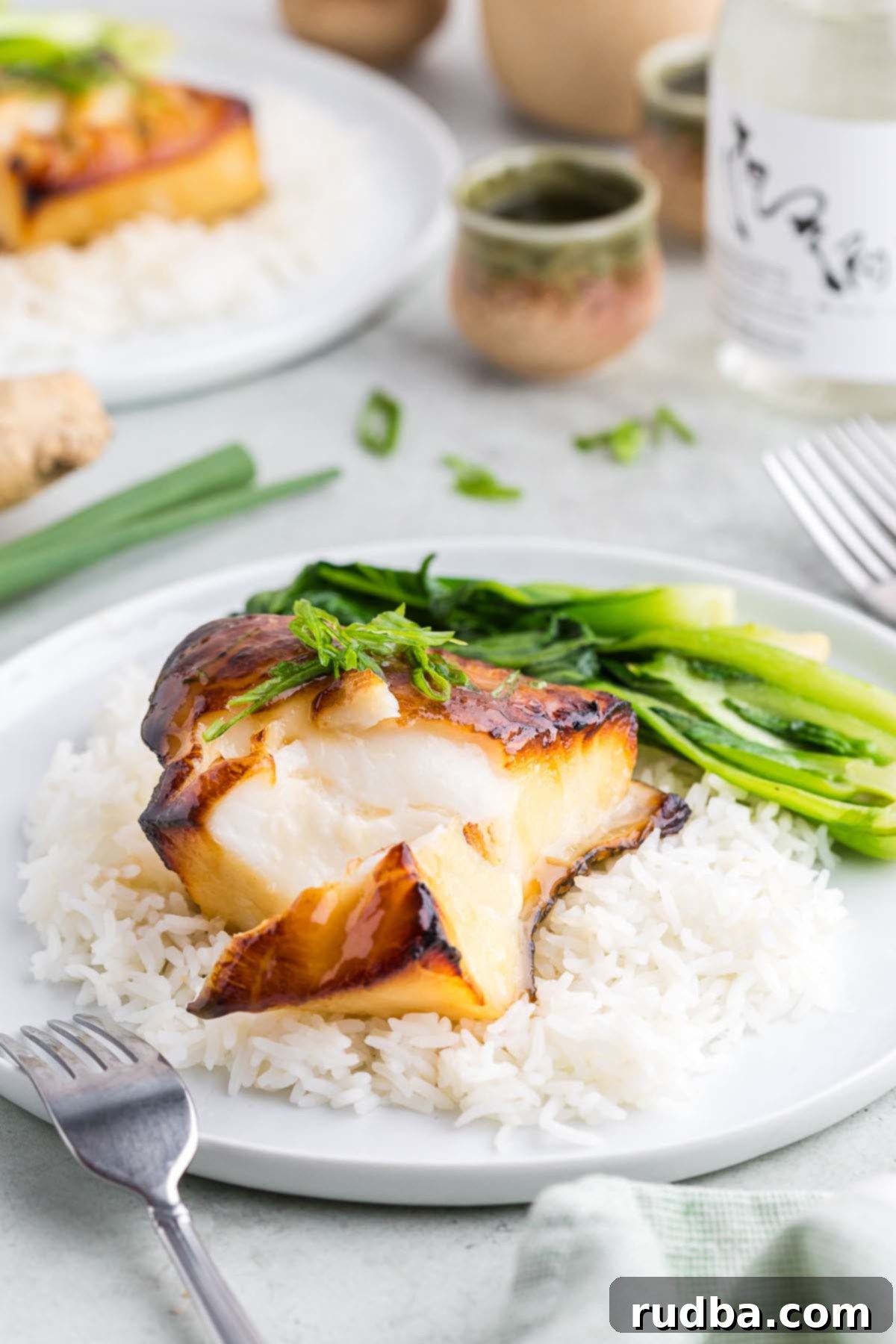
SERVING SUGGESTIONS
The beauty of this **Miso Glazed Chilean Sea Bass** lies in its versatility. Its rich, sweet, and savory flavor profile pairs wonderfully with a variety of sides, allowing you to create a complete and satisfying meal. Here are some ideas to inspire you:
- Rice: A classic pairing! Fluffy white rice, garlic buttery rice (as mentioned in the intro), or even brown rice provides a perfect neutral base to soak up any extra glaze.
- Steamed or Roasted Vegetables: Complement the fish with fresh, lightly cooked greens. Bok choy, asparagus, green beans, or broccoli florets are excellent choices. A simple drizzle of sesame oil or a sprinkle of toasted sesame seeds can enhance their flavor.
- Noodle Dishes: A light stir-fried noodle dish or a simple bowl of udon or soba noodles can be a fantastic accompaniment, adding another layer of texture and flavor.
- Quinoa or Couscous: For a healthier, grain-based option, serve the fish with a side of fluffy quinoa or pearl couscous.
- Simple Salad: A crisp green salad with a light vinaigrette can offer a refreshing contrast to the richness of the fish.
- Garnishes: Elevate the presentation and add a final touch of flavor with garnishes like thinly sliced green onions (scallions), toasted sesame seeds, or a light sprinkle of chili flakes for a hint of heat.
Don’t forget to serve with the reserved marinade as an extra sauce on the side – it’s perfect for drizzling over the fish and any accompanying rice or vegetables!
STORAGE & REHEATING
If you happen to have any delicious leftovers of this **Miso Glazed Chilean Sea Bass**, rest assured they can be enjoyed later! Here’s how to store and reheat them properly to maintain their flavor and texture:
- Storage: Allow the cooked fish to cool completely before transferring it to an airtight container. Store it in the refrigerator for up to three days.
- Reheating in the Oven: For best results and to prevent drying out, reheat the fish in a preheated oven. Place the fish on a baking sheet and cover it loosely with foil. Bake at 375°F (190°C) for approximately 8-10 minutes, or until just warmed through.
- Reheating in the Air Fryer: The air fryer is another excellent option for reheating, helping to maintain a slightly crisp exterior. Place the fish in the air fryer basket and cook at 375°F (190°C) for about 4-5 minutes, or until heated through.
- Reheating in the Microwave: While less ideal for texture, the microwave is the quickest option. Place the fish on a microwave-safe plate, cover loosely, and heat on medium power for about 1 minute, checking every 30 seconds to avoid overcooking.
Remember, always reheat leftovers until piping hot (165°F or 74°C internal temperature) to ensure food safety.
Tried this recipe? Please consider leaving a star ⭐️⭐️⭐️⭐️⭐️ rating in the recipe card below and/or a review in the comments section further down the page. Your feedback is greatly appreciated! And for more delicious recipes and cooking inspiration, don’t forget to follow me on Facebook or Pinterest!

Miso Glazed Chilean Sea Bass
Ingredients
- 2 pieces Chilean sea bass
- ¼ cup Sake, plain, not flavored
- ¼ cup mirin
- 3 tbsp White Miso paste, 58g
- 3 tbsp brown sugar, 37g
- 1/2″ fresh ginger cut into thin rounds, optional
Instructions
-
Combine sake, mirin, miso, and brown sugar in a small saucepan. Mix together with a whisk over medium heat until you achieve a homogeneous mixture. Continue to heat until the mixture comes to a gentle simmer, and simmer for about 1 minute to allow the flavors to meld. Remove from heat.
-
If your sauce has a lumpy texture (some miso brands contain rice particles), you can pour it through a fine-mesh sieve to achieve a smoother consistency.Add the sliced fresh ginger to the sauce and let it cool completely to approximately room temperature. You can place the saucepan in the fridge or an ice bath to speed up the cooling process.
-
Reserve about 3 tablespoons of the cooled marinade in a small bowl and set aside; this will be used as a finishing sauce for the cooked fish. Place the remaining marinade in a zipper-top bag and add the Chilean sea bass fillets. Ensure the fish pieces are thoroughly coated. Place the bag in the fridge to marinate overnight for optimal flavor. If you’re short on time, marinate for at least one hour. For shorter marination times, you can intensify the flavor after cooking by adding more of the reserved sauce over the fish once it’s on the plate.
-
Remove the marinated sea bass from the fridge about 20 minutes before cooking to allow it to come closer to room temperature for even cooking. Prepare a broiling pan or a sturdy baking sheet by lining it with aluminum foil or parchment paper for easy cleanup.
-
Preheat your oven to 400°F (200°C). Bake the Chilean sea bass for 10 minutes, then switch to the broiler setting and broil for an additional 1-2 minutes, watching carefully to achieve a beautiful caramelized glaze. If your fish pieces are larger than 4 ounces, continue cooking until the internal temperature reaches 145°F (63°C) for perfect doneness.
-
Serve your delicious Miso Glazed Chilean Sea Bass immediately with the remaining reserved sauce, if desired. Enjoy your restaurant-quality meal!
Notes
- The marinade is heated to help dissolve the miso paste and blend all the flavors. Be sure to cool it down completely before marinating the fish. Otherwise, the fish will begin to cook prematurely from the sauce’s heat, leading to overcooked fish.
- The thicker the fish, the longer it will take to cook through. The fish is done when the internal temperature reaches 145°F (63°C), or it flakes easily with a fork. If the top of the fish is browning too fast during broiling, lower the oven rack a bit.
- Allow the fish to marinate in the fridge for at least one hour, but preferably overnight, for the deepest flavor.
- Take the fish out of the fridge at least 20 minutes before cooking. You never want to cook cold fish straight from the fridge, as it will cook unevenly.
- Do not overcook the fish! Overcooking will result in dry, tough fish, losing its delicious, tender quality.
Nutrition
Nutrition information is automatically calculated, so should only be used as an approximation.
